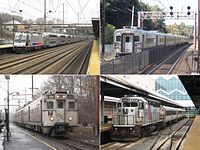
Princeton Junction is an unincorporated community and census-designated place (CDP) located within West Windsor, in Mercer County, in the U.S. state of New Jersey. As of the 2010 United States Census, the CDP's population was 2,465.

New Jersey Transit Corporation, branded as NJ Transit or NJTransit and often shortened to NJT, is a state-owned public transportation system that serves the U.S. state of New Jersey and portions of the state of New York and Pennsylvania. It operates bus, light rail, and commuter rail services throughout the state, connecting to major commercial and employment centers both within the state and in its two adjacent major cities, New York City and Philadelphia. In 2022, the system had a ridership of 175,960,600.
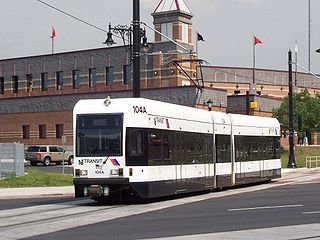
The Newark Light Rail (NLR) is a light rail system serving Newark, New Jersey and surrounding areas, operated by New Jersey Transit Bus Operations. The service consists of two segments, the original Newark City Subway (NCS), and the extension to Broad Street station. The City Subway opened on May 16, 1935, while the combined Newark Light Rail service was officially inaugurated on July 17, 2006.

The Hudson–Bergen Light Rail (HBLR) is a light rail system in Hudson County, New Jersey, United States. Owned by New Jersey Transit (NJT) and operated by the 21st Century Rail Corporation, it connects the communities of Bayonne, Jersey City, Hoboken, Weehawken, Union City, and North Bergen.

A branch line is a secondary railway line which branches off a more important through route, usually a main line. A very short branch line may be called a spur line. Branch lines may serve one or more industries, or a city or town not located on a main line. Branch lines may also connect two or more main lines.

Metropark station is an intermodal transportation hub on the Northeast Corridor in the Iselin section of Woodbridge Township in Middlesex County, New Jersey that is located 24.6 miles southwest of New York Penn Station. It is owned and operated by NJ Transit and serves Amtrak and NJ Transit's Northeast Corridor Line. NJ Transit runs peak period 'loop' buses in coordination with train schedules.
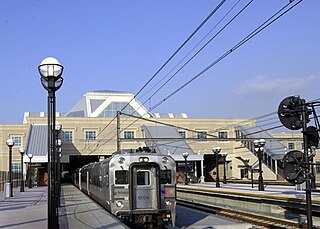
Secaucus Junction is an intermodal transit hub operated by New Jersey Transit in Secaucus, New Jersey. It is one of busiest railway stations in North America.

The Northeast Corridor Line is a commuter rail service operated by NJ Transit between the Trenton Transit Center and New York Penn Station on Amtrak's Northeast Corridor in the United States. The service is the successor to Pennsylvania Railroad commuter trains between Trenton and New York, and is NJ Transit's busiest commuter rail service. After arrival at New York Penn Station, some trains load passengers and return to New Jersey, while others continue east to Sunnyside Yard for storage. Most servicing is done at the Morrisville Yard, at the west end of the line. The Northeast Corridor Line is colored red on NJ Transit system maps and its symbol is the State House. The Princeton Branch is a shuttle service connecting to the line. Connecting SEPTA Trenton Line service between Philadelphia and Trenton is listed in the timetable.
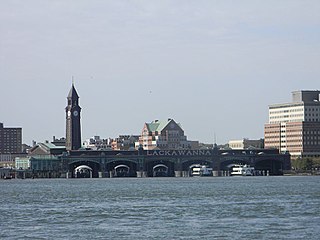
Hoboken Terminal is a commuter-oriented intermodal passenger station in Hoboken, Hudson County, New Jersey. One of the New York metropolitan area's major transportation hubs, it is served by eight NJ Transit (NJT) commuter rail lines, an NJ Transit event shuttle to Meadowlands Sports Complex, one Metro-North Railroad line, various NJT buses and private bus lines, the Hudson–Bergen Light Rail, the Port Authority Trans Hudson (PATH) rapid transit system, and NY Waterway-operated ferries.

Princeton Junction station is a railroad station in Princeton Junction, New Jersey, located in West Windsor Township. It serves NJ Transit (NJT) and Amtrak on the Northeast Corridor (NEC), and NJ Transit on the Princeton Branch.

Newark Liberty International Airport Station is a railroad station on the Northeast Corridor (NEC) in Newark, New Jersey. The station provides access to Newark Liberty International Airport (EWR) via the AirTrain monorail which connects the station to the airport's terminals and parking areas.

The Atlantic City Line (ACL) is a commuter rail line operated by NJ Transit (NJT) in the United States between Philadelphia, Pennsylvania and Atlantic City, New Jersey, operating along the corridor of the White Horse Pike. It runs over trackage that was controlled by both the Pennsylvania Railroad (PRR) and the Pennsylvania-Reading Seashore Lines. It shares trackage with SEPTA and Amtrak on the Northeast Corridor (NEC) until it crosses the Delaware River on its own Delair Bridge into New Jersey.
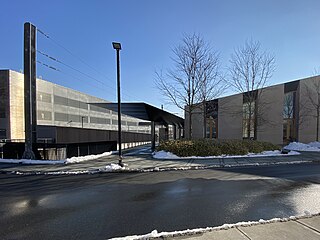
Princeton is the northern terminus of the Princeton Branch commuter rail service operated by NJ Transit (NJT), and is located on the Princeton University campus in Princeton, New Jersey. At the branch's southern end at Princeton Junction, connections are available to NJT's Northeast Corridor Line and peak-hour Amtrak trains. The shuttle train between the two stations is known as the "Dinky", and has also been known as the "PJ&B", for "Princeton Junction and Back". Now running 2.7 mi (4.3 km) along a single track, it is the shortest scheduled commuter rail line in the United States. Initial studies have been conducted to add a bus transitway along the Dinky right-of-way as part of a proposed bus rapid transit system.

Newark Broad Street station is a New Jersey Transit commuter rail and light rail station at 25 University Avenue in Newark, New Jersey. Built in 1903, the station's historic architecture includes an elegant clock tower and a brick and stone façade on the station's main building. In June 1984, the station was added to the National Register of Historic Places in recognition of its historical significance.
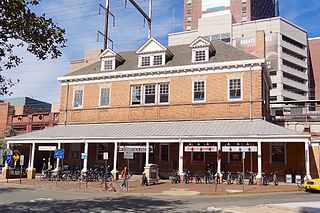
New Brunswick is an active commuter railroad train station in the city of New Brunswick, Middlesex County, New Jersey. The station services trains of New Jersey Transit's Northeast Corridor Line and Amtrak's Keystone Service and Northeast Regional. For New Jersey Transit trains, the next station to the southwest is Jersey Avenue, while the next station to the northeast is Edison. For Amtrak services, the next station southwest is Princeton Junction, the next station to the northeast is Metropark. The station consists of two handicap-accessible side platforms surrounding the four tracks.

The Passaic–Bergen–Hudson Transit Project is a project under study by NJ Transit to reintroduce passenger service on a portion of the New York, Susquehanna and Western Railway (NYSW) right-of-way (ROW) in Passaic, Bergen and Hudson counties using newly built, FRA-compliant diesel multiple unit rail cars. Plans call for service to run from Hawthorne south through Paterson, east to Hackensack and then southeast to North Bergen, where it would join the Hudson-Bergen Light Rail (HBLR).
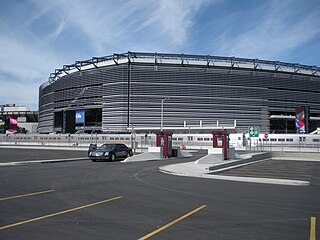
The Meadowlands Rail Line, branded as the BetMGM Meadowlands Rail Line as part of a naming rights agreement, is a rail line in New Jersey, United States, operated by NJ Transit Rail Operations (NJT). Trains run between the Meadowlands Sports Complex and Secaucus Junction, some with continuing service to Hoboken Terminal. There is limited service on the line, with trains only operating in conjunction with major events.

Bus rapid transit in New Jersey comprises limited-stop bus service, exclusive bus lanes (XBL) and bus bypass shoulders (BBS). Under the banner Next Generation Bus New Jersey Transit (NJT), the New Jersey Department of Transportation (NJDOT), and the metropolitan planning organizations of New Jersey (MPO) which recommend and authorize transportation projects are undertaking the creation of several additional bus rapid transit systems (BRT) in the state.
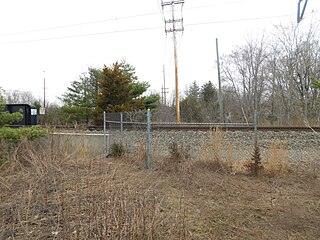
Penns Neck was a railway station of the Pennsylvania Railroad, in the Penns Neck neighborhood of West Windsor Township, New Jersey. It opened sometime between 1865 and 1875 as an intermediate stop on the newly completed Princeton Branch line, near its midpoint where it crossed the turnpike that is now U.S. Route 1. The location was originally a grade crossing and later a rail bridge.
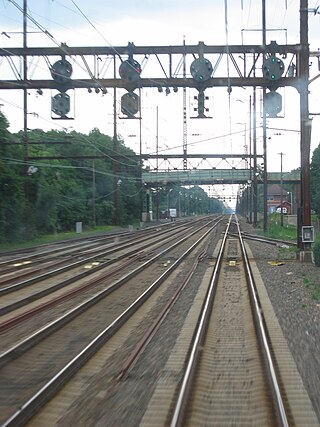
The Monmouth Ocean Middlesex Line (MOM) is a passenger rail project in the US state of New Jersey, proposed by NJ Transit Rail Operations (NJT) to serve the Central New Jersey counties of Monmouth, Ocean, and Middlesex. The line would originate/terminate around Lakehurst at its southern end. It would junction with either the Northeast Corridor Line or North Jersey Coast Line to provide service north to Newark Penn Station, with potential connecting or continuing service to Hoboken Terminal or New York Penn Station.























